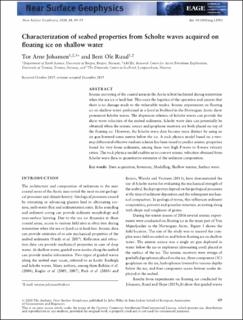Characterization of seabed properties from Scholte waves acquired on floating ice on shallow water
Journal article, Peer reviewed
Published version

Åpne
Permanent lenke
https://hdl.handle.net/11250/2755895Utgivelsesdato
2020Metadata
Vis full innførselSamlinger
- Department of Earth Science [1050]
- Registrations from Cristin [9791]
Sammendrag
Seismic surveying of the coastal areas in the Arctic is best facilitated during wintertime when the sea ice is land-fast. This eases the logistics of the operation and assures that there is no damage made to the vulnerable tundra. Seismic experiments on floating ice on shallow water performed in a fjord in Svalbard in the Norwegian Arctic show prominent Scholte waves. The dispersion relation of Scholte waves can provide the shear wave velocities of the seabed sediments. Scholte wave data can potentially be obtained when the seismic source and geophone receivers are both placed on top of the floating ice. However, the Scholte wave data become more distinct by using an air gun lowered some metres below the ice. A rock physics model based on a two-step differential effective medium scheme has been tuned to predict seismic properties found for very loose sediments, among these very high P-wave to S-wave velocity ratios. The rock physics model enables us to convert seismic velocities obtained from Scholte wave data to quantitative estimates of the sediment composition.
